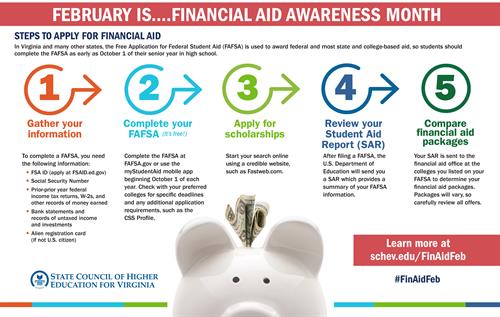Contact: Laura Osberger
lauraosberger@schev.edu
(804) 786-2323 (office) or (804) 387-5191 (mobile)
February 3, 2020
For immediate release
Richmond — Using financial aid to help offset college costs is often a necessary part of being able to afford college for many Virginia students. The application process alone can seem like a daunting task. But, during February – Financial Aid Awareness Month (#FinAidFeb) – the State Council of Higher Education for Virginia (SCHEV) breaks it down into five manageable steps to help students pay for college.

“Understanding how financial aid works is crucial,” said Peter Blake, director, State Council of Higher Education for Virginia, “because it comes from many different sources, including grants and scholarships, work-study, loans and tuition waiver and savings programs. The best part is that students may use a combination of these financial aid sources at the same time to make college even more affordable.”
Step 1: Gather Your Information
In Virginia and many other states, applying for federal and most state financial aid starts with completion of the Free Application for Federal Student Aid, or FAFSA. To complete a FAFSA, you need the following information:
- FSA ID (students and parents can apply for an FSA ID at FSAID.ed.gov)
- Social Security Number
- Prior-prior year federal income tax returns, W-2s, and other records of money earned (for example, you will need 2018 tax records for the 2020-21 FAFSA). You may be able to transfer federal tax return information into your FAFSA using the IRS Data Retrieval Tool.
- Bank statements and records of untaxed income and investments
- Alien registration card (if not a U.S. citizen)
Step 2: Complete Your FAFSA (It’s free!)
Complete the FAFSA at FAFSA.gov or use the MyStudentAid mobile app beginning October 1 of each year. Send your FAFSA to each of the colleges in which you are interested in attending. Check with your preferred colleges for specific deadlines and any additional application requirements, such as the CSS Profile. Colleges have different deadlines to submit the FAFSA and may have additional requirements to receive aid. March 1 is the most common priority deadline, but students should confirm dates for each college in which they are interested. Priority deadlines for Virginia’s public colleges and universities are located on SCHEV’s website.
Step 3: Apply for Scholarships
This is free money, which does not need to be repaid! The more you apply for, the better your chances of reducing the amount you pay out of pocket. Scholarships – of any size – are valuable because they may cover tuition, fees, room and board and/or books. Most scholarships are awarded based upon financial need or merit, such as academic achievement. Start your search online using a credible website, such as Fastweb.com. Scholarships are available through many sources, including schools, employers, banks, nonprofits, faith-based organizations and professional organizations.
Step 4: Review Your Student Aid Report (SAR)
After filing a FAFSA, you will receive a Student Aid Report (SAR) from U.S. Department of Education’s Federal Student Aid office. Your SAR will provide a summary of the information provided on your FAFSA. Once received, make sure you review it and make any needed corrections as soon as possible.
Step 5: Compare Financial Aid Packages
The information from your SAR, including your Expected Family Contribution (EFC), is sent to the financial aid office at the colleges you listed on your FAFSA. Colleges use this information to determine your financial need and award package, which may vary by college, so review your award letters carefully to help you make the best decision. Contact the college financial aid office if you have questions about your award package.
In 2018-19, the Commonwealth of Virginia awarded more than $279 million to institutions to support undergraduate student aid awards. Virginia’s primary state aid programs help Virginia residents attend public and private nonprofit two- and four-year institutions.
"When students know how to obtain financial aid, it can change the trajectory of their lives and careers,” said Virginia Secretary of Education, Atif Qarni. "During Financial Aid Awareness February – and throughout the year – we want to emphasize that Virginia students CAN afford to attend college, especially when they are aware of all the state, federal, and private resources available to them.”
Visit schev.edu/FinAidFeb for more information, and review the resources listed below.
ADDITIONAL RESOURCES
###
Media resources – including links to downloadable high-resolution photos and logos, news advisories and releases – are available at www.schev.edu/media.
The State Council of Higher Education for Virginia is the state’s coordinating agency for higher education. With The Virginia Plan for Higher Education, SCHEV is dedicated to making Virginia the best-educated state by 2030. For more on The Virginia Plan, visit this page.
